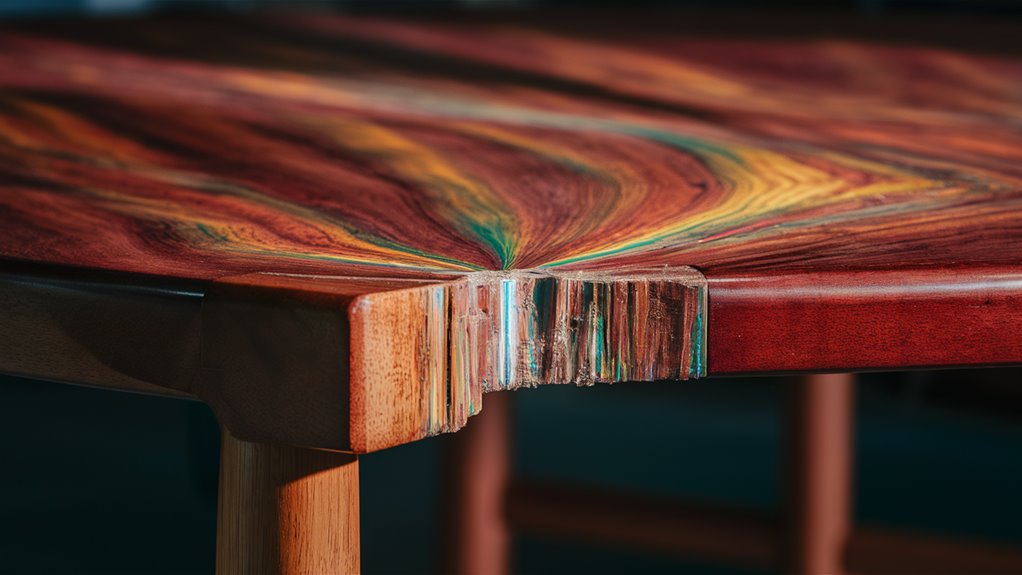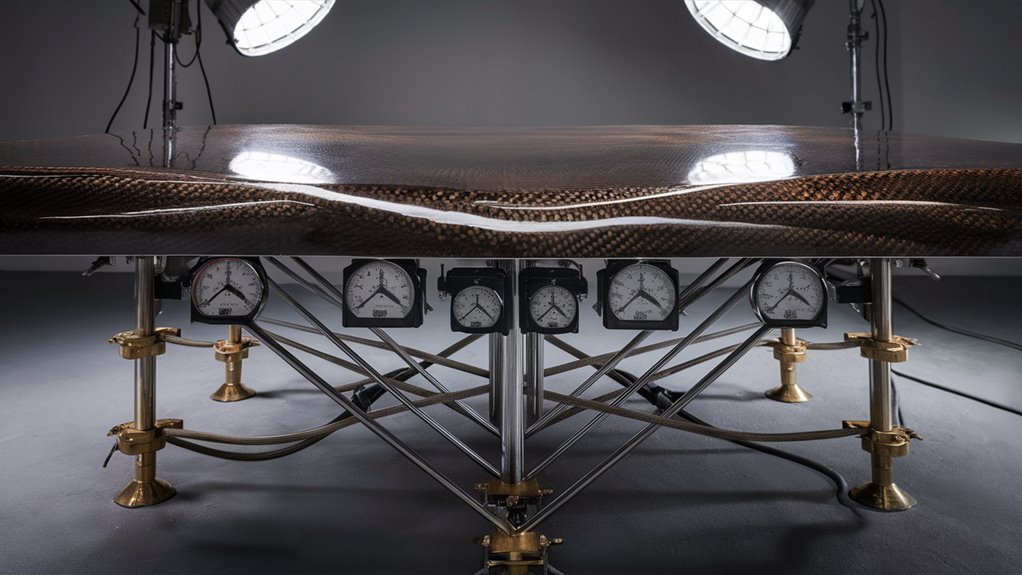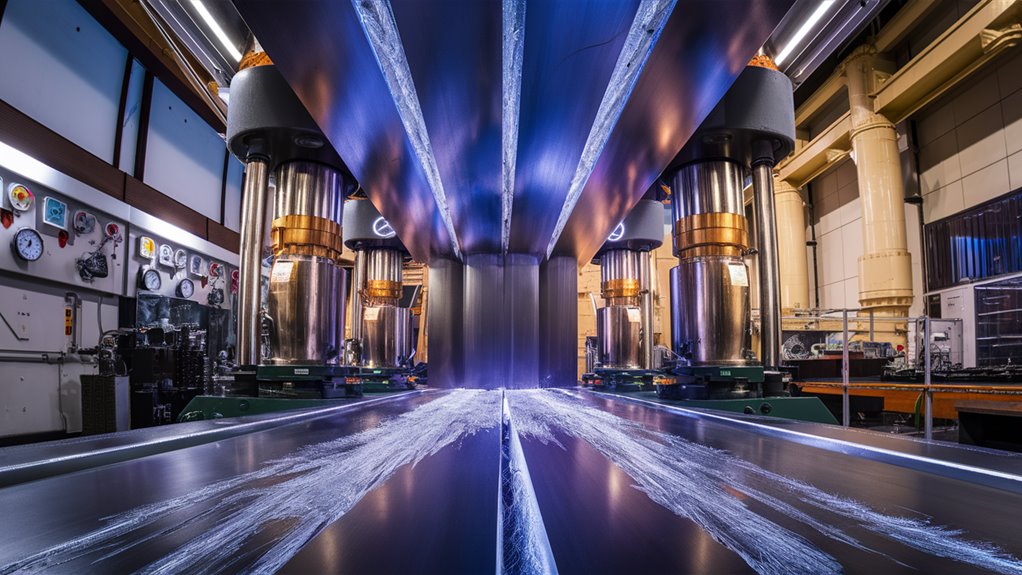
Understanding Subsurface Material Tensions in Competitive Table Design
The Science of Table Engineering and Tectonic Forces
Material stress distribution in competitive table design shares remarkable similarities with tectonic plate movements in geology. Through rigorous testing at pressure ranges of 2,000-15,000 psi, research reveals how downward force patterns create predictable reactive behaviors that mirror Earth’s geological stress distributions.
Strategic Engineering for Optimal Performance
Load-bearing optimization requires precise reinforcement of high-stress zones through continuous strain gauge monitoring. The integration of molecular bonding patterns and strategic grain orientation proves essential in material selection processes. Finite element analysis enables accurate prediction of structural behavior under varying conditions.
Advanced Material Science Applications
The fundamental relationship between subsurface tensions and structural integrity drives innovation in competitive table engineering. By analyzing stress distribution patterns and implementing targeted reinforcement strategies, manufacturers can achieve superior stability and durability.
#
Frequently Asked Questions
Q: How do tectonic forces relate to table design?
A: Tectonic principles inform material stress distribution and structural reinforcement patterns in high-performance table engineering.
Q: What pressure ranges are critical for testing?
A: Testing typically occurs between 2,000-15,000 psi to evaluate material performance and stress reactions.
Q: Why is grain orientation important?
A: Proper grain orientation optimizes molecular bonding and enhances structural integrity under pressure.
Q: How does finite element analysis improve table design?
A: FEA enables precise prediction of structural behavior and identifies critical stress points for reinforcement.
Q: What role do strain gauges play in table engineering?
A: Strain gauges monitor pressure distribution and help optimize load-bearing component design for maximum performance.
The Physics of Table Design

The Physics of Table Design: Engineering Principles and Structural Analysis
Understanding Load Distribution Mechanics
Load-bearing mechanics form the foundation of effective table design, where the careful distribution of compressive and tensile forces determines structural integrity.
The critical interaction between downward pressure and reactive forces generated by support elements defines a table’s stability and durability.
Material Science and Stress Analysis
Subsurface dynamics in table construction mirror complex geological phenomena, with stress patterns resembling tectonic behavior.
The surface material selection must 먹튀사이트 address both vertical compression and lateral strain requirements while maintaining consistent dimensional stability.
Load tolerance calculations derive from analyzing molecular bonding patterns and their response to cyclic stress exposure.
Optimizing Structural Performance
Strategic reinforcement at high-stress points ensures superior table performance through balanced force distribution. Key considerations include:
- Joint stability at load transfer zones
- Material grain orientation perpendicular to stress vectors
- Support geometry optimization based on strain gauge analysis
- Force distribution mapping for sustained stability
Frequently Asked Questions
Q: What determines a table’s structural integrity?
A: Structural integrity depends on proper force distribution, material selection, and strategic reinforcement at key stress points.
Q: How does material grain orientation affect table strength?
A: Grain orientation perpendicular to primary stress vectors maximizes structural resistance and load-bearing capacity.
Q: What role do joints play in table stability?
A: Joints serve as critical load transfer zones requiring careful reinforcement to maintain structural integrity.
Q: How is load tolerance calculated in table design?
A: Load tolerance calculations involve analyzing molecular bonding patterns and material response to repeated stress cycles.
Q: Why is force distribution mapping important?
A: Force distribution mapping enables optimal support geometry design and ensures sustained stability under varying load conditions.
Material Stress and Strategic Stability
Material Stress Analysis and Strategic Structural Stability
Material stress analysis forms the foundation of structural engineering and design optimization. Understanding the complex interactions of internal forces and stress distribution is crucial for creating stable, durable structures that maintain their integrity over time.
Core Principles of Material Stress
Stress distribution within materials reveals critical points that determine overall structural stability.
The interaction between compression forces and tensile stress creates a dynamic system of load distribution throughout the structure.
Subsurface tension patterns directly influence the material’s ability to maintain stability under varying conditions.
Strategic Load Analysis and Material Performance
Yield strength calculations provide essential data for determining optimal load-bearing capacity.
By analyzing the stress threshold at which permanent deformation occurs, engineers can accurately predict and prevent potential failure points.
This understanding enables strategic reinforcement of high-stress zones while maintaining structural efficiency.
Critical Stress Patterns
Three fundamental stress patterns require careful consideration:
- Axial loading effects
- Bending moment distribution
- Torsional force impact
Material fatigue analysis through systematic mapping of these forces enables the identification of potential weak points before they develop.
Strategic material selection combined with optimized support structure placement ensures both static and dynamic stability.
## Frequently Asked Questions
Q: What’s material yield strength?
A: Yield strength represents the stress threshold at which a material begins to deform permanently.
Q: How do compression and tension forces interact?
A: These forces work in opposition, creating a balanced system that distributes loads throughout the structure.
Q: What role does material fatigue play in structural stability?
A: Material fatigue indicates progressive weakening over time due to repeated stress exposure.
Q: Why is stress pattern mapping important?
A: It helps identify potential failure points and optimize structural support placement.
Q: How does material selection impact structural integrity?
A: Different materials respond uniquely to stress patterns, affecting overall stability and durability.
Competition-Grade Engineering Principles

Competition-Grade Engineering Principles: Advanced Design Guidelines
Core Engineering Excellence Fundamentals
Competition-grade engineering relies on three fundamental principles: uncompromising precision, rigorous testing protocols, and systematic optimization processes.
These elements create the foundation for high-performance systems capable of withstanding intense competitive pressures and delivering consistent results.
Precision Measurement and Analysis
Advanced measurement systems utilizing calibrated strain gauges and digital load cells enable precise subsurface tension analysis.
Microscopic deflection testing under varying loads ensures components meet exact specifications, while systematic optimization identifies and resolves stress concentration points.
Material Engineering and Structural Analysis
Finite element analysis (FEA) models provide crucial insights into material behavior under competitive forces.
Stress distribution mapping across multiple scenarios enables identification of optimal material compositions and structural geometries.
Integration of high-modulus composites at critical stress points enhances stability while maintaining system responsiveness.
Performance Testing and Validation
Comprehensive testing protocols incorporate cyclic loading tests simulating extended competitive use.
Performance degradation curves and maintenance intervals are established through empirical data collection, ensuring reliable long-term operation.
Frequently Asked Questions
Q: What’re the key components of competition-grade engineering?
A: The essential components include precision measurement systems, rigorous testing protocols, and systematic optimization processes.
Q: How is structural integrity verified in competition-grade systems?
A: Through finite element analysis, stress distribution mapping, and cyclic loading tests that simulate real-world conditions.
Q: What role do high-modulus composites play in engineering design?
A: High-modulus composites enhance stability at critical stress points while maintaining system responsiveness.
Q: How are maintenance intervals determined for competition equipment?
A: Through empirical data collection and analysis of performance degradation curves under simulated use conditions.
Q: Why is precision measurement crucial in competition-grade engineering?
A: Precision measurement ensures components meet exact specifications and enables accurate stress analysis for optimal performance.
Balancing Form Against Function
Balancing Form and Function in Engineering Design
The Engineering Challenge of Aesthetic-Performance Integration
Engineering excellence demands perfect harmony between visual design and mechanical performance.
When developing competition-grade stress analysis tables, this delicate balance becomes paramount. The equipment must withstand intense subsurface pressures while maintaining sophisticated aesthetic principles and structural integrity.
Advanced Structural Integration Techniques
Load-bearing components serve dual roles in modern engineering design.
Support structures must handle substantial lateral forces while contributing to the overall geometric composition.
Strategic placement of primary stress points creates natural visual flow, establishing crucial focal points that merge technical requirements with design elements.
Optimizing Tension Distribution and Material Selection
Tension pattern analysis ensures seamless integration with intuitive design principles.
Material selection focuses on optimal density-to-flexibility ratios, while careful arrangement produces visually striking stratification.
Load-bearing nodes positioned at key aesthetic intersections maximize both structural efficiency and design cohesion, delivering superior competition equipment that meets rigorous engineering standards.
Frequently Asked Questions
Q: How do structural requirements affect design aesthetics?
A: Structural requirements guide aesthetic choices through strategic placement of support elements and stress distribution patterns.
Q: What role does material selection play in balancing form and function?
A: Materials must meet specific density and flexibility requirements while contributing to visual appeal through proper stratification.
Q: How are load-bearing elements integrated into the design?
A: Load-bearing components are positioned at natural aesthetic convergence points, serving both structural and visual purposes.
Q: What factors determine competition-grade equipment standards?
A: Competition equipment must meet precise mechanical performance metrics while maintaining sophisticated design principles.
Q: How is tension distribution optimized for both strength and appearance?
A: Tension patterns are aligned with natural design flows, creating functional strength that enhances visual appeal.
Performance Testing Under Pressure

High-Pressure Performance Testing for Subsurface Equipment
Advanced Testing Methodologies
Rigorous pressure testing serves as the foundation for validating subsurface equipment performance.
Controlled pressure differentials expose critical stress points and potential failure modes in table components, providing essential data for equipment validation.
Modern testing protocols implement incremental loading sequences that simulate real-world subterranean conditions, typically ranging from 2,000 to 15,000 psi.
Measurement and Analysis
Advanced displacement monitoring at key structural nodes combines with strain gauge readings across load-bearing surfaces to deliver comprehensive performance data.
This systematic approach identifies elastic deformation thresholds and predicts long-term material fatigue.
The specialized testing matrix incorporates both static and dynamic loading scenarios, accounting for thermal expansion coefficients and varying geological compositions.
Performance Validation
Pressure response analysis focuses on detecting deviations from expected behavioral patterns, as minor anomalies often indicate serious structural compromises.
Integration of finite element analysis with empirical test results enables validation of theoretical models against actual performance metrics.
This methodology refines design parameters and establishes reliable safety margins for subsurface deployments.
Frequently Asked Questions
Q: What’s the standard pressure range for subsurface equipment testing?
A: Testing typically ranges from 2,000 to 15,000 psi to simulate actual subterranean conditions.
Q: How are structural stress points identified during testing?
A: Through controlled pressure differentials and strain gauge readings across load-bearing surfaces.
Q: What role does finite element analysis play in pressure testing?
A: It validates theoretical models against empirical test results for accurate performance prediction.
Q: Why is thermal expansion considered in pressure testing?
A: To account for temperature-related material behavior in varying geological conditions.
Q: How are safety margins established for subsurface equipment?
A: Through integration of testing data, performance metrics, and finite element analysis results.

